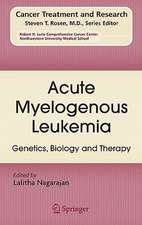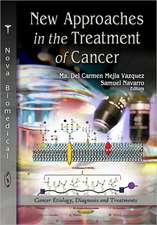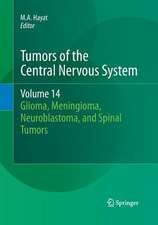Pediatric Cancer, Volume 4: Diagnosis, Therapy, and Prognosis: Pediatric Cancer, cartea 4
Editat de M.A. Hayaten Limba Engleză Hardback – 14 iun 2013
Coverage includes pediatric medulloblastoma, and treatments including craniospinal radiation followed by adjuvant chemotherapy. The contributors explain diagnosis and chemotherapy of children with acute lymphoblastic leukemia, and diagnosis of bone marrow involvement in pediatric lymphoma patients. Ewing’s sarcoma, a highly malignant connective tissue neoplasm formed by the proliferation of mesenchymal cells, receives extensive coverage, including targeting of molecular pathways and chemotherapy and surgical treatment. The roles of apoptotic genes, MYCN gene, MDM2, and SNP309, P13K inhibitors, alternative splicing and microRNAs, activated leukocyte cell adhesion molecule and inhibition by alu-like RNA in neuroblastoma are discussed in detail.
The book explores the molecular genetics, diagnosis, prognosis and therapy of the atypical teratoid/rhabdoid tumor (AT/RT). Among the most common malignant neoplasms in children, AT/RT exhibits similarities with other CNS tumors, which can lead to misclassification, as pointed out in the book. The contributors discuss diagnosis of AT/RT type using imaging technology, and describe new strategies, including intensive multimodal therapy and high dose chemotherapy with autologous stem cell transplantation that have shown improved outcomes. Coverage of therapies includes total resection followed by aggressive chemotherapy and radiation.
Discussion includes diagnosis and treatment of other pediatric tumors including adrenocorticaltumors, supratentorial primitive neuroectodermal tumors, giant midline tumors, gastrointestinal stromal tumors, ependymomas and intramedullary cavernoma.
Pediatric Cancer: Diagnosis, Therapy and Prognosis, Volume 4 includes contributions by ninety-one contributors - oncologists, neurosurgeons, physicians, research scientists and pathologists - representing thirteen countries.
The editor, M.A. Hayat, is a Distinguished Professor in the Department of Biological Sciences at Kean University, Union, New Jersey, USA.
| Toate formatele și edițiile | Preț | Express |
|---|---|---|
| Paperback (1) | 1419.56 lei 43-57 zile | |
| SPRINGER NETHERLANDS – 23 aug 2016 | 1419.56 lei 43-57 zile | |
| Hardback (1) | 1437.86 lei 43-57 zile | |
| SPRINGER NETHERLANDS – 14 iun 2013 | 1437.86 lei 43-57 zile |
Preț: 1437.86 lei
Preț vechi: 1513.53 lei
-5% Nou
Puncte Express: 2157
Preț estimativ în valută:
275.13€ • 288.03$ • 227.66£
275.13€ • 288.03$ • 227.66£
Carte tipărită la comandă
Livrare economică 07-21 aprilie
Preluare comenzi: 021 569.72.76
Specificații
ISBN-13: 9789400765900
ISBN-10: 9400765908
Pagini: 600
Ilustrații: XXXVI, 346 p. 55 illus., 32 illus. in color.
Dimensiuni: 178 x 254 x 22 mm
Greutate: 1.12 kg
Ediția:2013
Editura: SPRINGER NETHERLANDS
Colecția Springer
Seria Pediatric Cancer
Locul publicării:Dordrecht, Netherlands
ISBN-10: 9400765908
Pagini: 600
Ilustrații: XXXVI, 346 p. 55 illus., 32 illus. in color.
Dimensiuni: 178 x 254 x 22 mm
Greutate: 1.12 kg
Ediția:2013
Editura: SPRINGER NETHERLANDS
Colecția Springer
Seria Pediatric Cancer
Locul publicării:Dordrecht, Netherlands
Public țintă
Professional/practitionerCuprins
Preface. I. Neuroblastoma.- Pediatric neuroblastoma: use of hypermethylation of apoptotic genes as a prognostic factor.- Mycn nonamplified neuroblastoma: detection of tumor-derived cell-free dna in serum for predicting prognosis of neuroblastoma.- Neuroblastoma: role of mdm2 and snp309 as markers.- Role of pi3k inhibitors in sensitizing neuroblastoma cells to apoptosis.- Regulation of neuroblastoma cell differentiation by retinoic acid: role of alternative splicing and micro-rnas.- Neuroblastoma: role of activated leukocyte cell adhesion molecule.- Neuroblastoma: inhibition by alu-like rna.- Children with high risk neuroblastoma: prophylactic and therapeutic treatment with docosahexaenoic acid. II. Medulloblastoma.- Overview of treatment of pediatric medulloblastoma.- Event-free survival of children with average-risk medulloblastoma: treatment with craniospinal radiation followed by adjuvant chemotherapy.III. Leukemia.- Risk of childhood acute lymphoblastic leukemia: identification of inherited susceptibility.- Pediatric acute lymphoblastic leukemia: role of bim protein in prednisolone-induced apoptosis.- Infectious complications of antineoplastic chemotherapy in children with acute leukemia or solid tumors.- Pediatric leukemia of natural killer cells: diagnosis and multi-agent chemotherapy. IV. Lymphoma.- Pediatric lymphoma patients: cytomegalovirus infection.- Diagnosis of bone marrow involvement in pediatric lymphoma patients: fdg pet/ct versus bone marrow biopsy.-Survivors of childhood hodgkin’s disease after treatment: subsequent solid tumor malignancies based on gender and radiation dose.V. Rhabdoid.- Early childhood paraspinal atypical teratoid/rhabdoid tumor:failure of standard treatments.- Cerebral tumor with rhabdoid features.- Atypical teratoid/rhabdoid tumor of the pineal region: diagnosis. VI. Sarcoma.- Ewing’s sarcoma family of tumors: targeting molecularpathways and the race for a cure.- Ewing’s sarcoma: current concepts in chemotherapy and surgical control.- Pediatric epithelioid finger sarcoma: diagnosis and treatment.VII. Miscellaneous tumors.- Diagnosis and prognosis of pediatric patients with adrenocortical tumors.- Supratentorial primitive neuroectodermal tumor: therapy.- Giant pediatric midline tumors of the posterior fossa: surgery using combined transventricular and supracerebellar approach.- Pediatric gastrointestinal stromal tumor: pathology,genetics, and therapy.- Pediatric pituitary adenomas: germline genetic defects.- Pediatric ependymomas: role of methylation.- Pediatric intramedullary cavernoma: surgical treatment erwin cornips and mariel ter laak-poort.- Pediatric patients with bone malignancy: therapeutic options.- Late and acute effects of pediatric cancer therapy on the oral cavity.- Air embolism in a pediatric patient: a very rare complication of endoscopic retrograde cholangiopancreatography.- Index.
Textul de pe ultima copertă
This entry in the series Pediatric Cancer offers comprehensive information on a variety of cancers, concentrating on brain tumors, the most common solid tumors and the leading cause of cancer-related mortality in children. The contents are organized in seven sections: Neuroblastoma, Medulloblastoma, Leukemia, Lymphoma, Rhabdoid, Sarcoma and Miscellaneous Tumors.
Coverage includes pediatric medulloblastoma, and treatments including craniospinal radiation followed by adjuvant chemotherapy. The contributors explain diagnosis and chemotherapy of children with acute lymphoblastic leukemia, and diagnosis of bone marrow involvement in pediatric lymphoma patients. Ewing’s sarcoma, a highly malignant connective tissue neoplasm formed by the proliferation of mesenchymal cells, receives extensive coverage, including targeting of molecular pathways and chemotherapy and surgical treatment. The roles of apoptotic genes, MYCN gene, MDM2, and SNP309, P13K inhibitors, alternative splicing and microRNAs, activated leukocyte cell adhesion molecule and inhibition by alu-like RNA in neuroblastoma are discussed in detail.
The book explores the molecular genetics, diagnosis, prognosis and therapy of the atypical teratoid/rhabdoid tumor (AT/RT). Among the most common malignant neoplasms in children, AT/RT exhibits similarities with other CNS tumors, which can lead to misclassification, as pointed out in the book. The contributors discuss diagnosis of AT/RT type using imaging technology, and describe new strategies, including intensive multimodal therapy and high dose chemotherapy with autologous stem cell transplantation that have shown improved outcomes. Coverage of therapies includes total resection followed by aggressive chemotherapy and radiation.
Discussion includes diagnosis and treatment of other pediatric tumors including adrenocorticaltumors, supratentorial primitive neuroectodermal tumors, giant midline tumors, gastrointestinal stromal tumors, ependymomas and intramedullary cavernoma.
Pediatric Cancer: Diagnosis, Therapy and Prognosis, Volume 4 includes contributions by ninety-one contributors - oncologists, neurosurgeons, physicians, research scientists and pathologists - representing thirteen countries.
The editor, M.A. Hayat, is a Distinguished Professor in the Department of Biological Sciences at Kean University, Union, New Jersey, USA.
Coverage includes pediatric medulloblastoma, and treatments including craniospinal radiation followed by adjuvant chemotherapy. The contributors explain diagnosis and chemotherapy of children with acute lymphoblastic leukemia, and diagnosis of bone marrow involvement in pediatric lymphoma patients. Ewing’s sarcoma, a highly malignant connective tissue neoplasm formed by the proliferation of mesenchymal cells, receives extensive coverage, including targeting of molecular pathways and chemotherapy and surgical treatment. The roles of apoptotic genes, MYCN gene, MDM2, and SNP309, P13K inhibitors, alternative splicing and microRNAs, activated leukocyte cell adhesion molecule and inhibition by alu-like RNA in neuroblastoma are discussed in detail.
The book explores the molecular genetics, diagnosis, prognosis and therapy of the atypical teratoid/rhabdoid tumor (AT/RT). Among the most common malignant neoplasms in children, AT/RT exhibits similarities with other CNS tumors, which can lead to misclassification, as pointed out in the book. The contributors discuss diagnosis of AT/RT type using imaging technology, and describe new strategies, including intensive multimodal therapy and high dose chemotherapy with autologous stem cell transplantation that have shown improved outcomes. Coverage of therapies includes total resection followed by aggressive chemotherapy and radiation.
Discussion includes diagnosis and treatment of other pediatric tumors including adrenocorticaltumors, supratentorial primitive neuroectodermal tumors, giant midline tumors, gastrointestinal stromal tumors, ependymomas and intramedullary cavernoma.
Pediatric Cancer: Diagnosis, Therapy and Prognosis, Volume 4 includes contributions by ninety-one contributors - oncologists, neurosurgeons, physicians, research scientists and pathologists - representing thirteen countries.
The editor, M.A. Hayat, is a Distinguished Professor in the Department of Biological Sciences at Kean University, Union, New Jersey, USA.
Caracteristici
Offers comprehensive, up-to-date coverage of a broad range of pediatric tumors Discusses Neuroblastoma, Medulloblastoma, Leukemia, Lymphoma, Rhabdoid, Sarcoma and Miscellaneous Tumors Features the work of 91 experts - oncologists, neurosurgeons, physicians, research scientists and pathologists - representing 13 countries

























